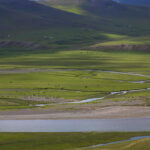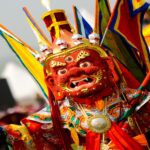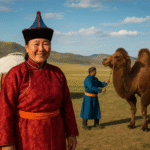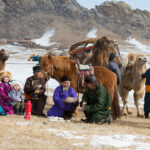Now Reading: The Rich and Fascinating History of Mongolia
-
01
The Rich and Fascinating History of Mongolia
The Rich and Fascinating History of Mongolia
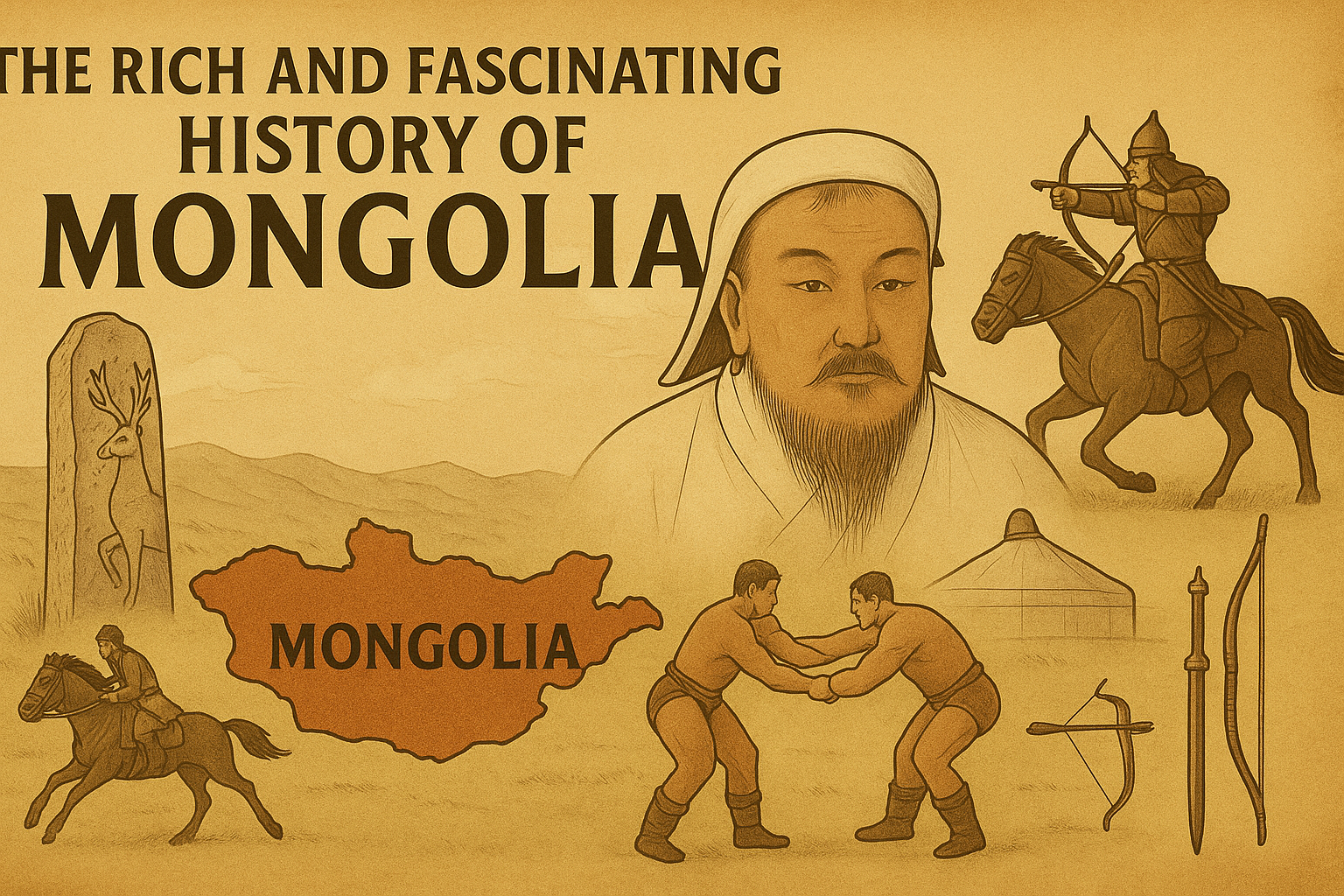
Mongolia is often imagined as an endless sea of grasslands dotted with yurts and herds of horses, but behind this romantic image lies a story of resilience, conquest, and cultural achievement. Few nations in the world have influenced history on such a vast scale while maintaining such a distinct identity. From the earliest nomadic clans who carved mysterious deer stones to the rise of Genghis Khan, whose empire reshaped continents, Mongolia has always stood at the crossroads of civilizations. Its history is not only about war and empire—it is also about survival in one of the harshest climates on Earth, the preservation of nomadic traditions, and the rebirth of a nation in the modern era.
Early Nomadic Cultures of Mongolia
The vast steppe of Mongolia has been home to human societies for thousands of years. Archaeological discoveries reveal that ancient tribes were living here during the Stone Age. Rock carvings, burial mounds, and bronze-era artifacts provide us with glimpses into the daily life of these people. Among the most mysterious monuments left behind are the deer stones—tall standing stones carved with images of flying deer, weapons, and sun motifs. These monuments date back nearly 3,000 years and show how spiritual and artistic early Mongolians were.
Life in these times was shaped by the environment. The harsh winters, strong winds, and lack of permanent farmland meant that survival depended on mobility. Early Mongolian tribes became expert horse riders, hunters, and herders. Horses were more than just animals—they became extensions of the people themselves, allowing them to travel long distances, herd livestock, and defend their clans.
The Xiongnu Empire
Around the 3rd century BCE, the Xiongnu Confederation emerged as the first powerful state in the Mongolian steppe. These nomadic warriors were formidable opponents of the Han Dynasty in China. Historical records describe constant wars, alliances, and treaties between the Xiongnu and the Chinese empire. The Great Wall of China itself was largely built as a defense against these northern horsemen.
The Xiongnu set the pattern for future steppe empires: tribal confederations united under a strong leader, supported by skilled cavalry, and capable of challenging even the greatest agricultural civilizations.
The Rise of Genghis Khan and the Mongol Empire
The most defining chapter in Mongolian history began in the 12th century with the birth of Temüjin, later known as Genghis Khan. His story is one of hardship, determination, and extraordinary leadership.
Childhood of Temüjin
Temüjin was born around 1162 into the Borjigin clan. His father was a tribal chief, but after being poisoned by enemies, Temüjin’s family was left abandoned and vulnerable. As a child, he experienced hunger, betrayal, and constant threats from rival tribes. These struggles shaped him into a resilient and ambitious leader.
Uniting the Tribes
Through alliances, diplomacy, and strategic warfare, Temüjin gradually united the fractured Mongol tribes. He implemented a system of meritocracy, rewarding warriors for loyalty and ability rather than noble birth. This policy attracted skilled followers and strengthened his army.
In 1206, at a grand assembly called a khuriltai, Temüjin was declared Genghis Khan, meaning “universal ruler.”
Expansion Across Continents
The Mongol armies became legendary for their speed, discipline, and devastating tactics. Using highly trained cavalry, intelligence networks, and innovative strategies like feigned retreats, Genghis Khan conquered vast territories. His empire stretched from the Pacific Ocean to Eastern Europe.
Cities such as Beijing, Samarkand, Baghdad, and Kiev came under Mongol rule or influence. By connecting East and West, the Mongol Empire reshaped global history.
Achievements of the Mongol Empire
While often remembered for their military conquests, the Mongols also brought significant cultural and economic changes.
- Silk Road Revival: The Mongols protected merchants and travelers, creating a safe trade environment. Goods such as silk, spices, paper, and gunpowder traveled freely across continents.
- Religious Tolerance: Unlike many empires, the Mongols allowed freedom of religion. Buddhists, Christians, Muslims, and others coexisted under Mongol rule.
- Communication System: The Yam relay system allowed messages to travel quickly across thousands of kilometers.
- Knowledge Exchange: The empire facilitated the spread of technologies, ideas, and medicine. For example, printing techniques from China and astronomy from the Islamic world reached Europe.
This period, known as Pax Mongolica (Mongol Peace), became one of the greatest examples of global interconnectedness before modern times.
Successor States After Genghis Khan
After Genghis Khan’s death in 1227, his empire was divided among his sons and grandsons, creating several powerful successor states:
- Yuan Dynasty (China) – Founded by Kublai Khan, who became emperor of China in 1271.
- Ilkhanate (Persia) – Covering Iran, Iraq, and surrounding regions.
- Golden Horde (Russia & Eastern Europe) – Ruling parts of modern-day Russia and Ukraine.
- Chagatai Khanate (Central Asia) – Stretching from the Aral Sea to Tibet.
Although the unified empire eventually fragmented, Mongolian influence remained strong for centuries.
Mongolia in the Later Centuries
After the fall of the Yuan Dynasty in 1368, Mongols retreated back to the steppe. Internal divisions weakened their unity, and the once-mighty empire was reduced to smaller khanates.
During the 16th and 17th centuries, Buddhism spread widely in Mongolia, shaping its cultural and spiritual identity. Monasteries became centers of learning, art, and medicine. However, this period also saw increasing pressure from powerful neighbors, especially the Qing Dynasty of China.
By the late 17th century, Mongolia was absorbed into the Qing Empire. For nearly 200 years, Mongolian identity was preserved mainly through nomadic traditions, language, and religion.
Mongolia’s Path to Independence
In the early 20th century, Mongolia sought independence as the Qing Dynasty collapsed. In 1911, Mongolia declared independence, establishing the Bogd Khanate. However, political instability, foreign intervention, and power struggles followed.
By 1921, with support from the Soviet Union, Mongolia secured independence from Chinese control. The Mongolian People’s Republic was established in 1924, making it the world’s second socialist country after the USSR.
During this period, Mongolia experienced rapid modernization but also faced hardships such as political purges and restrictions on religion. Many monasteries were destroyed, and thousands of monks were persecuted.
Mongolia in the Modern Era
With the fall of the Soviet Union in 1991, Mongolia transitioned to democracy and a free-market economy. This shift was not easy—economic struggles and political changes created challenges, but Mongolia emerged as a vibrant democracy in Asia.
Today, Mongolia balances its nomadic heritage with modernization. Ulaanbaatar, the capital city, has grown into a bustling urban center, while rural communities continue to live in traditional gers (yurts) and herd livestock.
Mongolia’s economy is now driven by mining, agriculture, and tourism. Travelers from around the world visit to experience the vast steppes, the Gobi Desert, and the legacy of Genghis Khan.
Cultural Legacy of Mongolia
Mongolia’s history is not only about conquests and empires but also about culture and identity. Some enduring elements include:
- Nomadic Lifestyle: Herding, horseback riding, and moving with the seasons remain core aspects of Mongolian identity.
- Naadam Festival: Featuring the “Three Manly Sports”—horse racing, wrestling, and archery.
- Music and Art: Throat singing (khöömei) and the horse-head fiddle (morin khuur) are unique cultural treasures.
- Buddhism: Despite repression in the 20th century, Buddhism remains a guiding spiritual force.
Conclusion
Mongolia’s history is one of remarkable endurance. From the ancient nomads and the Xiongnu to the mighty Mongol Empire and the struggles of modern nationhood, Mongolia has shaped world history in profound ways. The story of Mongolia is not only about past glory but also about resilience and cultural pride that continue to inspire its people today.
As the country looks toward the future, Mongolia stands as a nation deeply rooted in tradition while embracing global progress. Its history remains a reminder of how even a land of nomads can change the course of the world.


